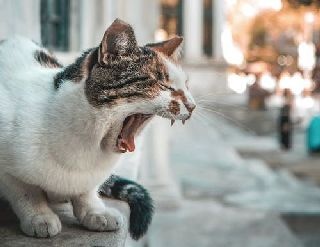Blog
Feline Trichobezoars
April 19, 2019

We've all been there. You tumble out of bed and SQUISH, you feel a wet surprise underfoot. For many cat owners, trichobezoars or hairballs are gifts that always seem to be in the middle of the floor when you are not awake enough to avoid stepping on them.
Hairballs are damp wads of undigested hair, moistened by bile and other digestive fluids, formed when a cat grooms itself and swallows the dead and loose hairs. If you have ever been licked by a cat, you know how rough their tongue is. Specialized papillae, turned back toward the throat, provide this roughness that traps shed fur. The fur is then swallowed a few pieces at a time. While most of this hair eventually passes through the intestines in small amounts, some of it remains in the stomach and gradually accumulates into the wet clump that you stepped on while getting ready for work.
Hairballs vary in size depending on the age of the cat, length of coat, diet, health status, and size of the mat; they are usually about an inch long but can be longer, cigar-shaped wads, the same color as your cat's fur.
In rare cases hairballs accumulate in the intestines or stomach, creating a blockage that necessitates surgical removal.
Here's what you can do to reduce hairball formation in your cat:
- Brush daily to remove shedding fur before your cat can ingest it
- Feed canned food, which helps trap fur in the stomach and encourages it to pass through the intestinal tract
- Consider professional grooming for longer-haired and denser coated cats
- Offer a hairball remedy once or twice a week to lubricate the ingested hair and help it pass through the stool
While it's not uncommon for a cat to vomit a hairball. If your cat is lethargic and refuses to eat for more than a day or has repeated episodes.



